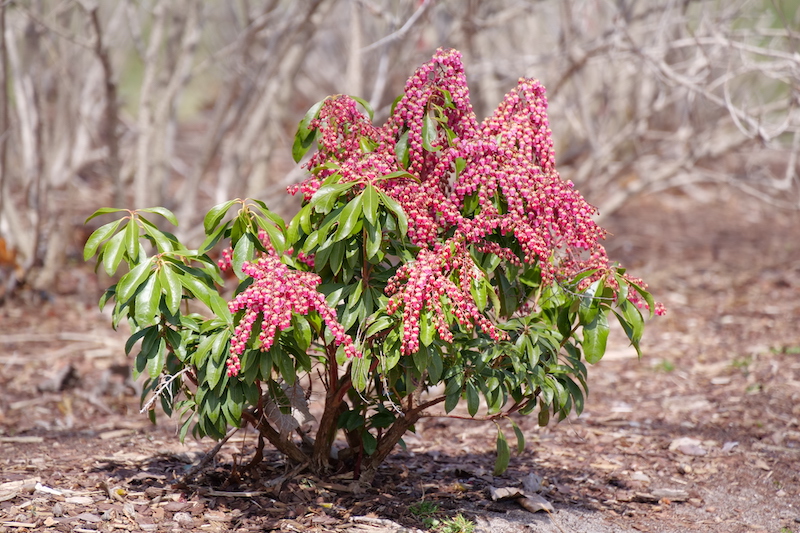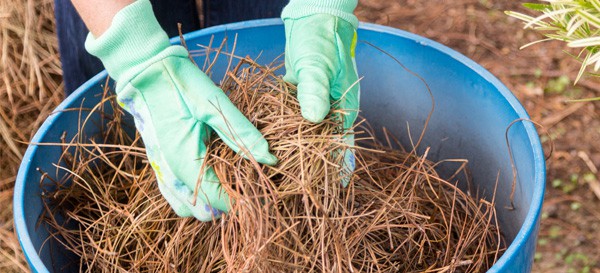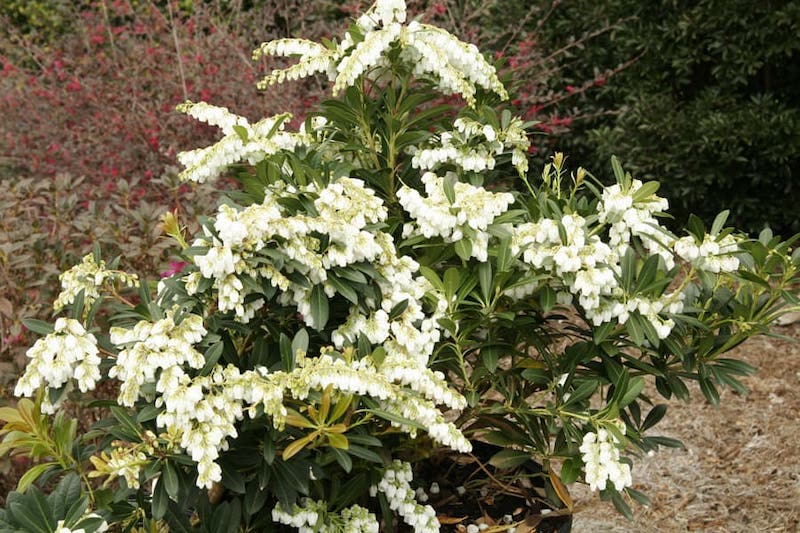Pieris japonica is also known by the common name Andromeda or Lily of the Valley bush. It is an ornamental broadleaf evergreen shrub that blooms in late winter or early spring and will give any garden a four-season backdrop of color and structure. Pieris has many cultivars that range in size from 12 inches tall to over 6 feet. They all prefer to be situated in partially shaded areas with just enough direct sun to help them bloom strongly.

What You Need To Plant Pieris
- Shovel or transplanting spade
- Location with partial shade or direct sun only in the morning
- Organic compost, shredded leaves, or arborist chips for mulch
- Watering can or hose
- Hand pruners

Where to Plant Pieris
The best location will have free-draining soil that is on the acid side of the pH scale. Pieris prefers partial shade, or full sun only in the morning and full shade the rest of the day. The soil texture can range from clay to sandy, as long as it drains well year round. Pieris naturally form the understory plantings in woodlands but should be planted well away from competing roots of large trees. Dry shade in these areas sometimes results in thin soil layers that are not deep enough for Pieris to establish well.

Pieris Spacing
Pieris are available in many different sizes, and every single cultivar requires good spacing between plants to allow for air circulation and for the shrubs to grow naturally without having to be pruned back hard. Heavy pruning of Pieris is the number one reason why these evergreen shrubs do not flower well. Most cultivars of Pieris naturally have a spread that is twice as wide as their height. Space plants so that each shrub can reach its mature size.
If the mature spread is 3-4 feet, then the plants should be planted 4 feet apart, as measured from the center of each plant. Pieris are often used as foundation plantings because their root systems are not an invasive threat to structures, and the shrubs appreciate a sheltered location during the winter.
Steps To Plant Pieris
Step 1 - Dig a hole that is as deep and twice as wide as the pot the shrub is growing in.
Step 2 - Carefully remove the plant from the pot, and gently tease out roots that are compacted or have started to circle the root ball.
Step 3 - Place the root ball in the hole at the same depth it was growing in the pot. Do not plant Pieris too deep in the ground or it will fail to thrive.
Step 4 - Replace the soil around the rootball, gently firming it in to make sure that all of the large air gaps are filled in.
Step 5 - Water the plant well, making sure to soak the soil all around the root ball. Allow all of the water to soak in well and then water the area a bit more.
Step 6 - Mulch around the base of the shrub, out to around 8 or 10 inches with an organic material that will decompose. Organic compost, shredded leaves, pine straw mulch, or arborist's chips work well.
Step 7 - Prune off any dead, diseased, or dying branches or any damaged parts from transplanting.
When to Plant Pieris
The best time of year to plant Pieris is early in the spring. The shrubs will be able to establish well over the spring and into the summer and be ready for winter. The second best time to plant Pieris is in the fall, especially if you garden in a warmer growing zone. The rains of winter will ensure that Pieris is kept moist and will bloom well in the spring.
Supplemental watering in the warmer months will be required for a year or more, no matter when you transplant Pieris into the garden. Applying a 2-3 inch layer of mulch will help to keep moisture in the soil and to insulate the root system from the heat in the summer and cold in the winter.
Transplanting Pieris
Pieris is a shrub that will not need dividing. This evergreen generally grows from a single trunk and splits into a multi-stemmed shrub. There is never any suckering of the root to take off or replant. It can be propagated from hardwood cuttings late in the fall or soft cuttings taken after blooming has finished in late spring. Make sure to take cuttings of non-flower-producing stems. Hardwood cuttings should always include a bit of the mature woody stem.
Transplanting Pieris from one location to another is not a difficult task and should be done after flowering is finished in late spring. Digging up a large root ball and watering consistently after transplant will make the move a success. Even if the shrub is mature when moved, treat it like a new planting for the next 2 years or so to give it plenty of help re-establishing.
 |
Author Robbin Small - Published 8-11-2022 |
